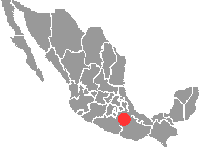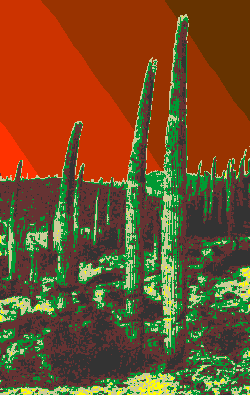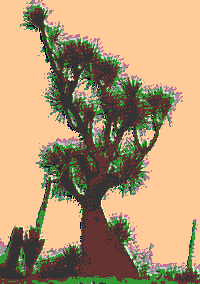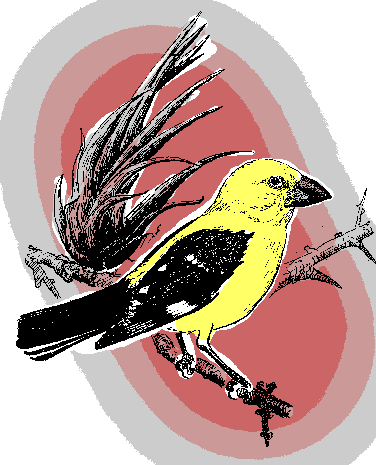 On Monday, November 11, with profound relief, I take a
bus from Mexico City toward the southeast, to Tehuacán in Puebla State. I choose a window
seat on the bus's right side so during the first part of the trip I can gaze at the
gorgeous 5452-meter high (17,887 ft) volcano Popocatépetl issuing its steady plume of
steam. Crossing the range from which Popocatépetl rises, at Río Frio, frost whitens the
landscape. Doting fields along the road are picturesque teepees of machete-cut corn
plants. It's a frost-killed, early winter scene, all gray and brown, and what a spectacle
a lone Vermilion Flycatcher presents perching on an electrical line.
On Monday, November 11, with profound relief, I take a
bus from Mexico City toward the southeast, to Tehuacán in Puebla State. I choose a window
seat on the bus's right side so during the first part of the trip I can gaze at the
gorgeous 5452-meter high (17,887 ft) volcano Popocatépetl issuing its steady plume of
steam. Crossing the range from which Popocatépetl rises, at Río Frio, frost whitens the
landscape. Doting fields along the road are picturesque teepees of machete-cut corn
plants. It's a frost-killed, early winter scene, all gray and brown, and what a spectacle
a lone Vermilion Flycatcher presents perching on an electrical line.
In Tehuacán I take a bus southwest to a place I've often visited but never was able to stay for long. Of all the spots on Earth I know, this has the greatest variety of succulents, particularly cacti, and I'm hoping the birds there will be spectacular, too. After climbing a good distance into a very rugged, arid and pretty landscape, late in the day I.disembark at Zapotitlán Salinas, usually just called Zapotitlán, near a roadside booth selling local onyx. The elevation here is about 1550 meters (5115 feet).
As the sun approaches the horizon, for about an hour I hike into the windswept desert not only looking for a good camping spot but also simply rejoicing in being back on the land. The cactus-filled landscape is a pure wonderland. A Phainopepla, a slender, crested, black bird, flashes white wing-patches as it darts about catching flying insects. How alert-looking this bird is, gracefully cocking its head this way and that.
 It's
that unsettled time of the evening when the desert's boulders reradiate heat stored up all
day, but the wind itself is getting chilly, and that wind is a stiff one. All around me
rises a vast community of unbranched, columnar, Saguaro-like cacti rising as high as the
rooftops of one-story houses, as shown at the right. Locally called Órganos,
botanists know them as Cephalocereus hoppenstedtii. And here's something
majestic: With the deep-shadowed, dark landscape behind them, these tall cacti appear as
pale, greenish-gray, vertical streaks rising all around, and in the stiff wind they are all
swaying together, as in a ghostly, rhythmic dance.
It's
that unsettled time of the evening when the desert's boulders reradiate heat stored up all
day, but the wind itself is getting chilly, and that wind is a stiff one. All around me
rises a vast community of unbranched, columnar, Saguaro-like cacti rising as high as the
rooftops of one-story houses, as shown at the right. Locally called Órganos,
botanists know them as Cephalocereus hoppenstedtii. And here's something
majestic: With the deep-shadowed, dark landscape behind them, these tall cacti appear as
pale, greenish-gray, vertical streaks rising all around, and in the stiff wind they are all
swaying together, as in a ghostly, rhythmic dance.
Finally I reach a small canyon with a silvery strand of water flowing through it. The canyon's walls rise only five or six stories high. A good arm could throw a rock from one canyon rim to the other. The stream averages only about a meter across (yard) but in this desert it's obviously a major presence, affecting life all around it. There's another Vermilion Flycatcher atop a rock at water's edge. Several Rough-winged Swallows perform acrobatics above the stream. Turkey Vultures land to roost among the naked branches of a small tree at the canyon wall's summit. When they land they look very unsteady and for five to ten seconds keep their wings open as if balancing, and they close their wings circumspectly, as if expecting to tip over.
I want to camp next to the stream. However, the walls are steep and where the walls meet the stream's floodplain thorny mesquite and other bushes form impenetrable tangles . I follow several wildlife trails, but each peters out inside spiny brush where going with a backpack is impossible. Several times I retrace my steps and try again.
With barely enough light to see, one wildlife trail finally leads onto the canyon floor. Wind streams down the canyon, cold wind now, and when finally I get the tent pegged beneath a mesquite the small tree's feathery leaves rustle pleasantly, the stream trickles softly just a few steps away, crickets chirp from leaf litter all around the tree, and frogs croak from a nearby pool of water. There is no traffic rumble, and no neurotic Doberman Pinscher barking.
"Escaped once again, " I whisper into the wind.
AN ECOLOGICAL ISLAND
 The Zapotitlán desert is an ecological island in the sense that it is
completely surrounded by non-desert biological communities. It occupies only a small
section of the southeastern corner of Puebla State, and the northwestern corner of Oaxaca
State. It owes its presence to the fact that right across the Tehuacán Valley to the
east, the Eastern Sierra Madres rise high enough to block prevailing winds carrying
moisture off the Gulf.
The Zapotitlán desert is an ecological island in the sense that it is
completely surrounded by non-desert biological communities. It occupies only a small
section of the southeastern corner of Puebla State, and the northwestern corner of Oaxaca
State. It owes its presence to the fact that right across the Tehuacán Valley to the
east, the Eastern Sierra Madres rise high enough to block prevailing winds carrying
moisture off the Gulf.
Similar to many oceanic islands, its inhabitants are often strange and unique. One of the most eye-catching is the Mexican Poneytail, Beaucarnea gracilis, shown at the right. Poneytails are sold as succulents in many North American garden shops, but the one sketched here has a trunk big as a full-sized refrigerator.
Botanist C.E. Smith Jr. writes that some 29 percent of the plant species found here are endemic -- found nowhere else on Earth. In fact, there are several endemic genera here. Some of those genus names look and sound wonderfully exotic: Oaxacania, Pringleochloa, Setchellanthus, Solisia...
I can't find literature about the birds. Who knows what I'll find here?
ENSNARED
At dawn it's 8° C (47° F), and wind keeps streaming down the canyon. Soon the wind picks up even more and a strange rattling fills the air. It's yucca leaves knocking against one another.
As sunlight creeps down the canyon's slopes I wander in the chilly, blue twilight pooled along the stream bed. The meager stream is "braided," splitting and coalescing repeatedly, and sometimes on the downstream side of boulders there are tadpole-filled pools. The canyon's floor is an unvegetated bed of rounded boulders and cobblestones interspersed with long, flat-surfaced sandbars on which grow elephants'-eye-high willows and mesquite. It's hard to walk on the cobblestones, so as I hike along the stream I hopscotch from one sandbar to the other.
On one sandbar, suddenly I find myself ensnared by several sticky threads or filaments stretched across the trail. Because the strands are as strong as cheap sewing thread the idea that I've walked into a spider web is slow to form, yet, what else could they be?
Trying to back out of the mess, a dark blob the diameter of a doorknob and seemingly suspended in mid air draws before my face, and then a second blob descends from the opposite side. It takes a moment to focus on them, but, indeed, they are very large spiders, gorgeous things with legs banded yellow and black, and their bodies mostly black, with yellow and white spotting. They are similar to North America's Garden Spiders, of the genus Argiope.
But no Garden Spiders ever made webs like these. About thirty typical sheet webs the size of window fans, with spiders in the middle of them and suspended at various levels, are all spread against the wind streaming down the canyon. The open area in which the webs are strung is about 4.5 meters wide (fifteen feet), and the topmost web reaches some three meters high (ten feet). Passing vertically through the center of each web is a slender collection of sucked-dry husks of insect victims, now strung together with silk, like beads.
Some webs connect to one another but others stand apart. All, however, are interconnected through a sticky maze of tough threads of the type I wandered into. It's easy to visualize small birds becoming entrapped in this system, but there's no indication that this has happened.
Some spiders are smaller and more slender than others, so they are probably males. When a web is approached too closely, its spider so violently slings its body back and forth perpendicularly to the plane of the web that the web pulsates. A vagrant breeze bursts into the opening, the entire community of upset spiders begins bobbing, and the resulting multi-dimensional system of oscillating webs is psychedelic, disorienting, maybe even a bit threatening, and that's probably the object of the whole display.
BIRDLIST #10
Here is this stop's Official List:
MEXICO: Puebla; ±5 kms SE of Zapotitlán, ±2-0 kms SW of Tehuacán; elev. ±1550 meters (±5,100 feet); small canyon with shallow stream about 2 m across, floodplain about 50 m wide, surrounded by desert with many cactus species
permanent resident
winter resident
not found in the USA
- Black Vulture
- Turkey Vulture
- Red-tailed Hawk
- White-winged Dove
- Common Ground-dove
- Gray-breasted Woodpecker
- Western Kingbird
- Vermilion Flycatcher
- Brown-crested (Wied's) Flycatcher
- Black Phoebe
- Northern Rough-winged Swallow
- Scrub Jay
- Boucard's Wren
- Northern Mockingbird
- Blue-gray Gnatcatcher
- White-lored Gnatcatcher
- Phainopepla
- Loggerhead Shrike
- Yellow Grosbeak
- Towhee
- Bridled Sparrow
THREE ENDEMIC BIRDS
Unlike the situation with plants, here I find no bird species endemic just to the Zapotitlán Desert. However, three species on the list are more broadly endemic to the highlands of southern Mexico north of the Isthmus of Tehuantepec. They are
- Gray-breasted Woodpecker
- Boucard's Wren
- Bridled Sparrow
The Gray-breasted Woodpecker is part of cluster of "zebra-backed" species very similar to eastern North America's common Red-bellied Woodpecker. Some ornithologists have lumped two or more of the species in the cluster together, but others insist that they are all separate. In other words, here evolution is at an in-between stage, where races are very well delimited, but it's debatable whether the races are species yet.
A similar case exists with the Boucard's Wren, which is an 18-cms-long bird (seven inches) very closely related to, and sometimes lumped with, the more widely distributed and more northern Spotted Wren, which we saw in the canyon at Bahuichivo. Both of these wrens are part of a cluster of species closely related to the Cactus Wren so common in the northern desert. In fact, some authors refer to the two wrens as the Boucard Cactus-wren and the Spotted Cactus-wren.
Of the three endemics, only the Bridled Sparrow is recognized even by the lumpers as a clearly distinct species. Still, it's obviously related to the Five-striped Sparrow of the Western Sierra Madres, and the Black-chested Sparrow of southwestern Mexico. These are all handsome, dark sparrows with heads boldly streaked with white.
